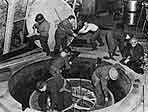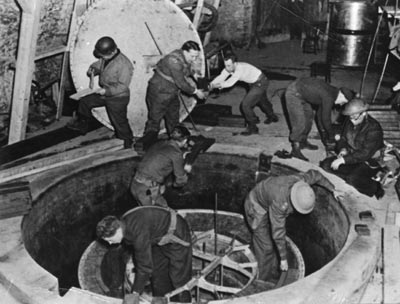The German Uranium Project
Secret tape recordings made at Farm Hall in England, where German scientists
were confined after World War II, show that Werner Heisenberg did not know how to
calculate the critical mass of uranium in 1945, indicating that he did not work on atomic
bombs during the war.
by Hans A. Bethe
Physics Today, July 2000
URL: http://www.aip.org/pt/vol-53/iss-7/p34.html
During World War II, the German atomic scientists were trying to produce electric
power by creating a chain reaction in uranium. Werner Heisenberg hoped that this
achievement would impress the allies if the war was lost.
To get a chain reaction in natural uranium you need a
moderator to slow down the neutrons that are generated from fission. This was widely
known. Two moderators were believed to be possible: carbon or heavy water.
Walter Bothe, the leading experimental nuclear physicist in
Germany, did the crucial experiment and concluded that carbon in the form of graphite
would not work. In America, Enrico Fermi did a similar experiment and concluded that
graphite was marginal. He suspected that an impurity in the graphite was responsible for
the problem. Leo Szilard, who was working alongside Fermi, had studied chemical
engineering before going into physics. He remembered that electrodes of boron carbide were
commonly used in the manufacture of graphite. It was known that one atom of boron absorbs
about as many slow neutrons as 100,000 atoms of carbon. Very small boron impurities would
"poison" the graphite for use as a nuclear reaction moderator. Szilard therefore
went around to the American graphite manufacturers and convinced one of them to make
boron-free graphite. Using this pure graphite as the moderator, the American group
achieved a chain reaction on 2 December 1942.
 The
German team, however, needed to use heavy water, D2O. Ordinary water contains
heavy water at a rate of about 1 part in 10,000. The two can be separated by repeated
electrolysis, which requires large amounts of electric power in close proximity to a water
source. The Germans had this at a hydroelectric plant in occupied Norway, and they set up
a separation facility there. The British alerted the Norwegian underground that heavy
water was useful for the war, without telling them why. Courageous Norwegians sabotaged
production as best they could. As a result the Germans had only about half the heavy water
they needed by the end of the war.
The
German team, however, needed to use heavy water, D2O. Ordinary water contains
heavy water at a rate of about 1 part in 10,000. The two can be separated by repeated
electrolysis, which requires large amounts of electric power in close proximity to a water
source. The Germans had this at a hydroelectric plant in occupied Norway, and they set up
a separation facility there. The British alerted the Norwegian underground that heavy
water was useful for the war, without telling them why. Courageous Norwegians sabotaged
production as best they could. As a result the Germans had only about half the heavy water
they needed by the end of the war.
Despite the shortage of heavy water, Heisenberg continued
to work toward a chain reaction to the very end of the war. What else could he have done?
Graphite was not an alternative; he had no reason to doubt Bothe's measurement. Bothe was
the recognized authority in the field and Germans believed strongly in authority. Even if
another German had repeated the experiment, the result would have been unchanged. No
German physicist would have consulted a chemical engineer: The barrier between the two
disciplines was too great. It would have been equally impossible to accelerate heavy water
production. To do so would have required additional electric power sources in an already
power-constrained economy.
The best evidence we have suggests that Heisenberg had
no interest in building an atomic bomb. In mid-1942, Albert Speer, the weapons minister,
asked Heisenberg whether he could produce a weapon in nine months. With a clear conscience
he could answer "No." And he did not know how much fissionable material he would
need. When, on occasion, friends asked him, his replies were varied and vague, ranging
from 10 kilograms to a few tons.
Why didn't he know? Why hadn't pure intellectual curiosity
led him to investigate the properties of uranium-235 with fast neutrons? He could have
made a small amount using the cyclotrons available in both Paris and Copenhagen. But he
never asked that these properties be measured. The best proof of his lack of interest came
at the end of the war. Heisenberg and about ten other German nuclear scientists were
interned at Farm Hall, a country estate in England. All of their conversations were
secretly taped. When the news of the Hiroshima atomic bomb was broadcast, these scientists
could not believe it. When they recognized that it was real, they asked Heisenberg how it
could have been done. His first attempt at explanation was totally wrong! He hypothesized
something like a nuclear reactor, with the neutrons slowed by many collisions with a
moderator.
That he was capable of doing the work was shown about a
week later when, in another lecture, he corrected himself and presented a theory similar
to that worked out by Rudolf Peierls and Otto Frisch in 1940. He estimated the necessary
amount of uranium-235 at about 20 kg, which is nearly correct. These two lectures prove to
me that Heisenberg, the scientific leader of the German effort, did not work on a bomb.
They show that he did not know critical information, and that he could have derived the
information if he had tried.
The British government kept the Farm Hall transcripts
secret for nearly half a century. Why? Allegedly the German government had requested the
concealment, but it should have been eager to have them published. Unless you assume that
they were afraid of what the transcripts would show, the secrecy was foolish. Farm Hall is
the real proof that the Heisenberg group had not worked on an atomic bomb. Around 1990
several fellows of the Royal Society urged publication. They convinced the Lord
Chancellor, and so the transcripts are now in the public domain.
If he wasn't trying to build a bomb, then why did
Heisenberg work on the uranium project? He told me, in 1948, that he wanted to save the
lives of a few young German physicists for the post-war period. I believe that this was
indeed an important argument for him. And in judging his behavior during the war, we must
remember that he was under enormous pressure, pressure virtually unimaginable for
Americans or Englishmen.
So Heisenberg didn't try to build a bomb, and apparently
had no intention of doing so. Why then the visit to Niels Bohr in 1941? What was he trying
to communicate? What did he hope to accomplish?
When Bohr came to Los Alamos at the end of 1943, he told J.
Robert Oppenheimer that Heisenberg had talked to him about an atomic bomb. Bohr reproduced
from memory a rough drawing that Heisenberg had shown him. The drawing was given to Edward
Teller and me, and we immediately recognized it as a nuclear reactor with many control
rods. What did Heisenberg intend to say with this drawing? Perhaps, "Look, this is
what we are trying to build and you will recognize that this is a reactor, not a
bomb." If so, he overestimated Bohr's knowledge of atomic power. Perhaps he was
trying to get Bohr to be a messenger of conscience, and wanted Bohr to persuade the allied
scientists also to refrain from working on a bomb. According to journalist Thomas Powers,
this message was repeated by Wolfgang Gentner, another non-Nazi German physicist, some
time later.1 But Bohr didn't understand — and neither he nor
the US would have trusted the message in any case.
I recently became aware of a statement made by Heisenberg
in 1965, in which he said approximately: "It was from September 1941 that we saw an
open road ahead of us, leading to the atomic bomb." How is this to be reconciled with
my assessment and with Heisenberg's statement at Farm Hall that he did not work on the
bomb, but only on the "engine" — that is, a reactor?
The explanation is that the Germans rejected the separation
of uranium isotopes as too difficult. They saw the fissionability of plutonium as the key
to the entire project. Once you had a chain reaction you could make plutonium, and once
you had plutonium, you could make a bomb. However, if they had achieved the reactor, they
would have found that the road from there to a bomb was still full of obstacles.
I based this article on a talk I gave at the symposium
"Creating 'Copenhagen,' " held at the Graduate Center of the City University of
New York on 27 March 2000.
Reference
1. T. Powers, Heisenberg's War: The Secret History of the German Atomic Bomb,
Knopf, New York (1993).
© 2000 American Institute of Physics
Hans Bethe (1906-2005) spent most of his career as a
professor of physics at Cornell University in Ithaca, New York. He arrived at Cornell as a
refugee from Nazi Germany in 1935 at age 28. It was at Cornell, before World War II, that
Bethe conducted his groundbreaking work on the theory of energy production in stars, for
which he won the Nobel Prize in 1967. During the war, Bethe was a key figure on the
Manhattan Project as head of the theoretical physics division.
(In accordance with Title 17 U.S.C. Section 107, this material is
distributed without profit to those who have expressed a prior interest in receiving the
included information for research and educational purposes.)
Germany's last atomic pile being dismantled

Germany's last atomic "pile," or reactor, was built in a cave
laboratory at Haigerloch in southern Germany. The reactor never ahieved criticality
—
a self-sustaining nuclear chain reaction — because
of lack of materials and time. In 1945, after World War II ended in Germany,
American soldiers (shown here) dismantled the device and then blew up the cave.
 The
German team, however, needed to use heavy water, D2O. Ordinary water contains
heavy water at a rate of about 1 part in 10,000. The two can be separated by repeated
electrolysis, which requires large amounts of electric power in close proximity to a water
source. The Germans had this at a hydroelectric plant in occupied Norway, and they set up
a separation facility there. The British alerted the Norwegian underground that heavy
water was useful for the war, without telling them why. Courageous Norwegians sabotaged
production as best they could. As a result the Germans had only about half the heavy water
they needed by the end of the war.
The
German team, however, needed to use heavy water, D2O. Ordinary water contains
heavy water at a rate of about 1 part in 10,000. The two can be separated by repeated
electrolysis, which requires large amounts of electric power in close proximity to a water
source. The Germans had this at a hydroelectric plant in occupied Norway, and they set up
a separation facility there. The British alerted the Norwegian underground that heavy
water was useful for the war, without telling them why. Courageous Norwegians sabotaged
production as best they could. As a result the Germans had only about half the heavy water
they needed by the end of the war. 